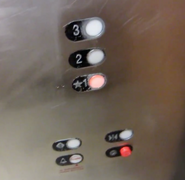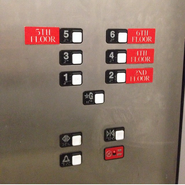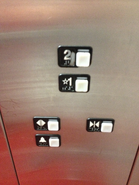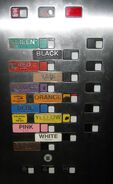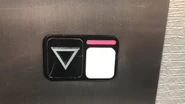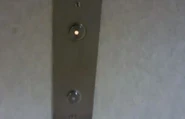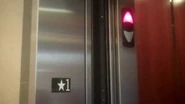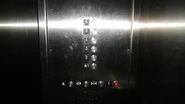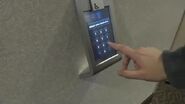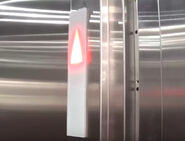- For Schindler elevator fixtures found in Asia, Europe and other regions, please refer to List of Schindler elevator fixtures.
This is a list of Schindler elevator fixtures which are only found in the United States and Canada.
1989 to 2008
PEP
When Schindler bought out Westinghouse's elevator division in 1989, it carried the use of PEP buttons. The button consists of a white button that lights usually with a wraparound braille, where the call button has triangle arrows printed in the button along with the alarm and door buttons. The fixture is made by Adams, where the buttons use Adams Survivor contacts. PEP refers to the braille, which there were two kinds. PEP-AS is with silver tactile, while PEP-AM is with muntz (brass) tactile. The buttons are often referred to as "RT," although this is an inaccurate term, as EPCO catalogs show it as PEP. It's also possible Westinghouse/Schindler called them RT, while EPCO/Adams called them PEP, although this isn't confirmed. PEP is usually used on Car Panels, while the Call Stations typically use a Custom Style Adam's Survivors button with an outer button ring (usually gray), and an Arrow Design similar to Westinghouse AE. Sometimes, they use those Adams Survivors buttons on the Car Panels instead of PEP. The floor indicator on PEP installations can either be non-pushable PEP buttons that light up, or a red two-digit seven-segment EPCO LED indicator with directional arrows on the left that MT fixtures use. The car lanterns have two opaque plastic triangles where it usually has a yellowish-white illumination, but early installations have two lanterns installed in the same direction at the highest or the lowest floor. PEP fixtures were also used for fire service on vandal resistant car stations. PEP fixtures were discontinued around 2004.
MT
Schindler MT fixtures were first made in 1989 and became their competitor to Dover Impulse, Otis Series 1, and Montgomery Vector (and later Montgomery Kone Series 220) fixtures. These fixtures typically use triangular, round, or square lens lanterns, along with a rectangular button assembly with a square braille plate, white square button, microswitch (made by Saia Burgess Controls of Switzerland[1]), and illuminating LED red rectangular light above the button. The floor indicator is a red, two-digit seven-segment LED indicator with the directional arrows on the left, and it's also used on some PEP installations. MT car lanterns consist of two opaque plastic triangles where it usually has a yellowish-white illumination, where the hall lanterns are the same as the car lanterns, but they are thicker and can be mounted above the door positioned with the floor indicator. MT fixtures can be mounted with M-Line fixtures which had a few installations in the United States. These fixtures are another type of the fixtures made by Epco and provided by Schindler. They were also provided on the low-rise Schindler 500A elevators. MT fire service can be found on a few Schindler 330A installations along the standard HT fixtures in Massachusetts. Schindler MT fixtures were discontinued in around 2008.
"Long Bar" MT
This is a rare variant to the standard MT fixtures made from the late 1980s-mid 1990s where the indicator and lanterns are the same but the light above the button is slightly wider as well as it use different button switches which are stiffer. The fire service key-switches are also often different. This variant would be discontinued around 1995.
MT Vandal Resistant
These are very similar to the HT vandal resistant (HT VR), but it has a standard MT indicator instead and the lamp in the button is green, white, yellow or red. The buttons are the California version of Adams / Epco Survivor Plus, although there are a few elevators with the Non-Californian version of Survivor Plus. The call button panels are generally the same as RT but with VR buttons instead. Not much is known about MT Vandal Resistant because they are not as common as Schindler's other fixtures and it probably was the Schindler equivalent to Dover Vandal Resistant, Otis Series 2 and Series 4, and Montgomery Kone "Vandal Resistant" (They used Innovation Security actually).
1998 to present
HT
HT fixtures started in 1998 and were used in Schindler 321A elevators, and were later used on the Schindler 330A, 400A, and HXpress modernization series. The floor indicator is a red two-digit seven-segment LED display with small up/down arrows on both sides of the display.
HT has many different variations, which are shown below.
HT (Standard)
The standard version of the HT fixtures are the basic fixtures used in the 330A (hydraulic), and 400A (traction) models. HT buttons consist of white rectangular buttons with a red LED illumination with a braille attached. The car operating panel used in 321A/330A is a curved panel and 2 buttons wide, while the panel used in 400A is flat and wider panels as well as 4 buttons wide. The call buttons are triangle shaped that lights up red with no braille plates, while the lanterns consist of rounded triangles with a speaker between the arrows. Originally the floor indicator had the Schindler logo on the right side on the indicator but this was removed in 2006 when Schindler introduced its current corporate identity. Below the floor indicator is an embossed Schindler logo. This practice originated in Europe with its D-Series and FI MXB/MXV fixtures.
Recently produced HT fixtures no longer feature embossed Schindler logo, and capacity badge is written in Frutiger, Schindler's standard corporate typeface, instead of Univers[2].
HT Premium
Introduced in 2001 with the 330A, HT comes in a premium variety that replaces the black Lexan-esque plastic call station with stainless steel or brushed brass. Other than the change in the call station and the option for the button to have white LEDs, they are the same as standard HT in the interior.
HT Vandal Resistant
HT also comes in a vandal-resistant version which was introduced in 2001 with the 330A. They are very similar to Schindler MT Vandal Resistant, except for the smaller HT indicator and the placement for the phone button. HT vandal-resistant buttons are stainless steel, with a white dot in the center the illuminates in red when pressed, and they are the California version of Survivor Plus, made by Adams / Epco. The car lanterns are very similar to MT/RT, except it illuminates red, while the hall lanterns are usually jamb-mounted with a speaker between the arrows. The car operating panel is wider on a 400A with the alarm and phone button located on the same row with the door buttons. Phone button locations vary between the 330A (between fire service and the floor buttons) and the 400A (in the same area as the door controls and alarm).
Chimes
There are three known type of chimes found on HT elevators.
The first HT elevators originally used chimes that were lower pitched than the ones they use now. They were installed in 1998 on 321As as well as on early 330A installations up until 2003-04. The current chime introduced in 2003-04 is much slower than the low-pitched chime, and were installed on 330As past 2003-04, as well as on most if not all 400As. The only difference between 330As and 400As are the floor passing chimes.
The two mentioned types of chimes above were thought to be the only two chimes HT elevators used. However, on March 28, 2014, YouTube user Ih8escalators discovered a Schindler 321A installed in 1998 with extremely rare chimes, which are lower than the common low-pitched chimes. This elevator can be found at Macy's Furniture Gallery in Carle Place, New York, and it is currently the only known elevator as of today that has that chime still intact. These chimes were discontinued due to ADA regulations, and it was the same problem the more-common low-pitched chimes had. Many rumors for the chime change was either due to the "ugly sound", the chime being too quiet, or due to how short the low pitched chimes compared to the higher pitched chime. Another possible reason was due to the sound of the down-direction chimes in the discovered elevator - first tone is lower and next is higher (most common and accepted down-direction chime construction with different tones are higher tone first, lower tone next). Schindler never confirmed these rumors, but many 321As/330As had their chimes upgraded to the current chimes in compliance with ADA.
Z-Line
- Further Information: Schindler Elevator Fixtures Guide (Z-Line sections)
Z-Line are keypads used in the Miconic 10 and SchindlerID destination dispatch elevators. They are installed in the elevator lobby. There are three versions of Z-Line keypads used in the American Schindler elevators. The first one, which is the early version, features black buttons and a simple red coloured LED dot matrix display. They could also be in a form of a standalone pillar. The second version, which is a rare version, features a larger panel, black wedged buttons, and blue illuminated LCD display. The third and latest version was the European/Asian version, with boxless design, grey wedged buttons and LCD display which lights up blue. The destination indicator displays inside the car are the same type as the one used in other countries.
Z-Line keypad were discontinued in 2012 when the Schindler PORT system was introduced. In addition, a keypad in the elevator for registering floors is not allowed in the United States. However, the in-car destination indicators that were used in Miconic 10 and SchindlerID systems are still in production today for elevators working with the PORT system.
PORT terminals
These are standard hall destination terminals/components for The PORT Technology. The current PORT fixtures available in North America are PORT 1 Series and PORT 4 Series.
PORT 1 Series (wall-mounted)
PORT 1 Series are touch screens with a unique curved design. They are either wall-mounted or pedestal type, and are either silver or black coloured. They can also be mounted on turnstiles for PORT system integrated with turnstiles. If a handicap mode is included in the system, there is a special button above the screen with an international wheelchair icon and tactile marks[3].
PORT 4 Series
These are flat touch screens with a glass design that are either flush-mounted or surface-mounted. There was also a pedestal version but it might have been discontinued. An example of this touch screen can be found in the World Trade Center 4 and Marriott Marquis in New York City, NY.
FI G
FI G was a American Version and these fixtures are used on 3100, 3300, and 3300 XL elevators.
FI GL 100 Line
FI GL 100 Line, or simply known as FI GL was introduced to both the United States and Canada in 2011 when the Schindler 3300 MRL elevators were launched in the North American market. These fixtures have a slightly different look compared to the European and Asia Pacific version. The hall stations are mounted on the door frame, featuring square stainless steel buttons with a ring tactile and a white dot LED on the top left corner. The car stations have square buttons which light up red when pressed. In very rare instances, call buttons can be wall-mounted instead of being usually mounted on the door frame. Floor indicators are red LED digital segments displays. Earlier versions of the indicators only included a 7 segment LED display. Later on, around 2014, they started using 16 segment LED displays. There are no touch-sensitive buttons as they are non-ADA compliant. These fixtures are officially discontinued in 2016-17 and replaced with FI GS.
FI GS 100
FI GS 100[4] was introduced to the United States in September 2016 when the Schindler 3100 was launched to the North American market[5]. Unlike the version found in Europe and Asia Pacific, the buttons does not have braille or tactile due to ADA compliance. Instead, there is braille plate attached to the buttons[6]. At the same time the 3100 was launched, Schindler 3300 elevators switched over to using FI GS fixtures, although the majority of installs started in around mid-2017. It is also used on most Schindler 3300 XL installations. It looks very similar to the American version of Linea 100 fixtures (see below), which are used in Schindler 5500 elevators. There is also a California Code Compliant version of these fixtures.
Linea
Linea was a American Version and these fixtures are used on 3100, 3300, 3300 XL and 5500 elevators.
Linea 100 White Edition
- Further Information: Schindler Elevator Fixtures Guide (Linea 100 sections)
These fixtures are used only on the American 5500 and some 3300 XL elevators. They look exactly the same as the ones used in Europe and Asia Pacific, except with added braille plates and no tactile on the buttons due to ADA compliance[7]. The glass on the hall stations and indicators are either white, but most commonly white. There is also a California Code Compliant version of these fixtures. And it similar in black edition.
Linea 100 Black Edition
Linea 100 black edition is introduced in 2015. It was a dot matrix and is similar in white edition.
Linea Vetro
Linea Vetro was introduced in 2015 it has a TFT-LCD indicator.
Linea VR
Linea VR was introduced in 2015 it has dot matrix.
There were two versions vandal resistant fixtures used only on the American 5500 and some 3300 XL elevators. The first had EPCO Survivor Plus California Compliant fixtures, just like Vandal Resistant HT.
The second has EPCO Endurance buttons. The glass on the exterior indicators are black, and the glass on the interior indicators are white. Unlike regular Linea 100, there is no option to pick between colors, nor is there glass on the hall station. There is also a California Code Compliant version of these fixtures. There might be an option to have a TFT-LCD Floor Indicator with these fixtures, although this isn't confirmed.
Third-party/generic fixtures
Adams
- Further information: List of Adams elevator fixtures
EPCO
- Further information: List of Epco elevator fixtures
Elevator Products Corporation (EPCO) is Schindler's fixture division. EPCO is just like any other third party elevator company like Innovation, GAL, etc. EPCO also makes some fixtures that are only used on Schindler elevators. EPCO was bought out by Westinghouse in the mid 1980s. After Schindler bought Westinghouse, EPCO continued to make Westinghouse AE too, however EPCO's Westinghouse AE was not specifically just for Schindler. EPCO made the Westinghouse AE fixtures for any elevator installs. Westinghouse AE was renamed Circleline and joined the EPCO fixture line that could be used on any elevator instead of joining Epco's fixture lines that were made for Schindler. Adams is also a division of Schindler and makes the PEP line.
See also
- List of Schindler elevator fixtures - for fixtures found in Asia, Europe and other regions.
- List of Westinghouse elevator fixtures
- List of Haughton elevator fixtures
Notes and references
- ↑ Detailed Look and Wiring of Schindler MT Elevator Buttons - YouTube
- ↑ Schindler 330A Hydraulic Elevators at The Hilton Garden Inn in Roanoke, VA
- ↑ Schindler's Port Technology - Easy as 1-2-3
- ↑ Schindler 3100/3300 elevator fixtures
- ↑ New Schindler 3100 MRL Traction Elevator Offers Cost-Effective Solution for 2-3 Story Buildings
- ↑ Schindler 3100 brochure (North America)
- ↑ Schindler 5500 elevator fixtures
